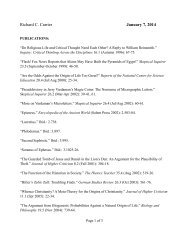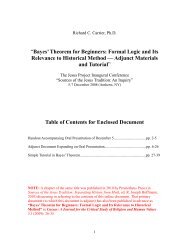Cultural History of the Lunar and Solar Eclipse in ... - Richard Carrier
Cultural History of the Lunar and Solar Eclipse in ... - Richard Carrier
Cultural History of the Lunar and Solar Eclipse in ... - Richard Carrier
Create successful ePaper yourself
Turn your PDF publications into a flip-book with our unique Google optimized e-Paper software.
stars, 100 <strong>and</strong> Plutarch knew this (loc. cit.). Aga<strong>in</strong>, experts who tra<strong>in</strong> <strong>the</strong>ir eyes to look<br />
for specific stars might be able to fa<strong>in</strong>tly make <strong>the</strong>m out, but this is not <strong>the</strong> same effect<br />
as be<strong>in</strong>g ‘dark as night’. Usually, Venus is <strong>the</strong> only o<strong>the</strong>r object <strong>in</strong> <strong>the</strong> sky visible dur<strong>in</strong>g<br />
an eclipse, <strong>and</strong> <strong>the</strong>n <strong>of</strong> course only if it is above <strong>the</strong> horizon at <strong>the</strong> time. Second,<br />
contrary to popular assumption, predict<strong>in</strong>g solar eclipses has never been a very exact<br />
science until quite recently, with <strong>the</strong> development <strong>in</strong> <strong>the</strong> mid-1980’s <strong>of</strong> computer<br />
programs <strong>and</strong> precise data adequate to <strong>the</strong> task. And calculat<strong>in</strong>g eclipses backwards is<br />
still not an exact science, due to a little known problem: <strong>the</strong> moon <strong>and</strong> <strong>the</strong> Earth are<br />
decelerat<strong>in</strong>g, 101 a fact totally unknown <strong>in</strong> antiquity, <strong>and</strong> <strong>the</strong>y are decelerat<strong>in</strong>g unevenly<br />
<strong>and</strong> unpredictably. 102 Though <strong>the</strong> deceleration rate is very small, over thous<strong>and</strong>s <strong>of</strong><br />
years <strong>the</strong> significance is great enough that calculat<strong>in</strong>g solar eclipses <strong>in</strong> <strong>the</strong> past is<br />
subject to unknown errors. In fact, while historians use eclipses to calibrate<br />
chronology, 103 astronomers are do<strong>in</strong>g <strong>the</strong> reverse, by us<strong>in</strong>g ancient eclipse reports to<br />
calibrate estimates <strong>of</strong> <strong>the</strong> decelerations. 104<br />
C. Ancient Uses <strong>of</strong> <strong>Eclipse</strong> Data<br />
The use <strong>of</strong> eclipses for historical dat<strong>in</strong>g is actually not as recent an idea as commonly<br />
thought: <strong>the</strong> ancient Romans are <strong>in</strong> fact <strong>the</strong> first known to attempt this. Plutarch<br />
reports 105 that Varro had commissioned <strong>the</strong> astrologer Tarutius to calculate <strong>the</strong> year<br />
<strong>and</strong> day <strong>of</strong> <strong>the</strong> birth <strong>of</strong> Romulus, go<strong>in</strong>g on <strong>the</strong> <strong>the</strong>ory that an eclipse <strong>of</strong> <strong>the</strong> sun <strong>the</strong>n<br />
occurred (as aga<strong>in</strong> at <strong>the</strong> found<strong>in</strong>g <strong>of</strong> Rome). Though this was a good idea, except for<br />
100 Newton, p. 37; Bicknell gives useful modern data on <strong>the</strong> frequency <strong>of</strong> ‘dark’ eclipses <strong>of</strong> <strong>the</strong> moon (p. 160-1),<br />
<strong>and</strong> he takes <strong>the</strong> ancients seriously (though not competently) by posit<strong>in</strong>g a series <strong>of</strong> unusually dark eclipses <strong>in</strong> need<br />
<strong>of</strong> explanation, a <strong>the</strong>sis which was soundly refuted by Sto<strong>the</strong>rs. Literary embellishment or borrow<strong>in</strong>g is <strong>the</strong> most<br />
likely explanation.<br />
101 Schove, p. xvii, xxi; <strong>the</strong> location is <strong>the</strong> most difficult detail to calculate, more than <strong>the</strong> time, cf. Newton, p. 113;<br />
<strong>the</strong> deceleration <strong>of</strong> <strong>the</strong> moon is due to <strong>the</strong> tidal forces <strong>of</strong> gravity, <strong>of</strong> earth <strong>the</strong> same th<strong>in</strong>g, as well as, amaz<strong>in</strong>gly<br />
enough, w<strong>in</strong>d, <strong>and</strong> water condensation <strong>and</strong> evaporation. The gravitational effect is somewhat calculable, but<br />
wea<strong>the</strong>r can’t even be predicted a week <strong>in</strong>to <strong>the</strong> future, much less thous<strong>and</strong>s <strong>of</strong> years <strong>in</strong>to <strong>the</strong> past. Coral studies<br />
show that <strong>the</strong> Earth’s year was 400 days long <strong>in</strong> <strong>the</strong> early Cambrian period. To make matters worse, <strong>the</strong> moon is<br />
slowly retreat<strong>in</strong>g, astronomers estimate today that it is over 400 feet far<strong>the</strong>r from <strong>the</strong> Earth than <strong>in</strong> 1 A.D., which<br />
also affects calculations (Schove, p. xxvii.).<br />
102 Newton, p. 1-3.<br />
103 S<strong>in</strong>ce <strong>the</strong>y only need an acuracy with<strong>in</strong> one day -- although <strong>in</strong> Western records, only three eclipse reports <strong>in</strong> <strong>the</strong><br />
first four centuries actually <strong>in</strong>clude <strong>the</strong> month <strong>and</strong> day: 45 A.D., 59 A.D., <strong>and</strong> 346 A.D.; cf. Schove, p. 2. Pl<strong>in</strong>y <strong>the</strong><br />
elder (Natural <strong>History</strong>, 2.70.(180)) gives <strong>the</strong> time <strong>and</strong> place <strong>of</strong> <strong>the</strong> 59 A.D. eclipse <strong>and</strong> is correct to with<strong>in</strong> half an<br />
hour, mak<strong>in</strong>g this <strong>the</strong> best extant solar eclipse record <strong>in</strong> <strong>the</strong> West (Schove, p. 11-13).<br />
104 The science beh<strong>in</strong>d this is very complicated <strong>and</strong> will not be discussed here (cf. Schove, Newton, Fo<strong>the</strong>r<strong>in</strong>gham<br />
for examples). But <strong>in</strong> regard to <strong>the</strong> use <strong>of</strong> ancient solar eclipse reports for historical reasons, a good deal <strong>of</strong> caution<br />
is <strong>in</strong> order. As <strong>the</strong> modern astronomer Robert Newton elegantly puts it, “Most <strong>of</strong> what <strong>the</strong> technical literature has to<br />
say about ancient solar eclipses is wrong,” quoted <strong>in</strong> Schove, p. ii, who goes on to detail all <strong>of</strong> <strong>the</strong> difficulties <strong>and</strong><br />
necessary sources, as well as catalogue <strong>and</strong> discuss all <strong>the</strong> ancient reports <strong>of</strong> <strong>the</strong> common era. Modern<br />
developments have also made some older work obsolete: e.g. <strong>the</strong> st<strong>and</strong>ard resource, Oppolzer, has some maps<br />
sufficiently outdated to be hundreds <strong>of</strong> miles <strong>of</strong>f <strong>the</strong> currently calculated marks.<br />
105 Romulus, 12.2-6.








